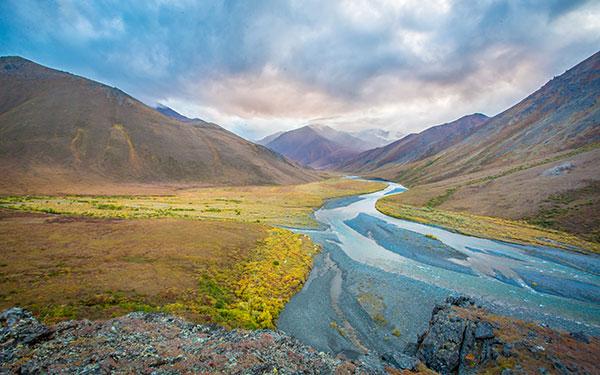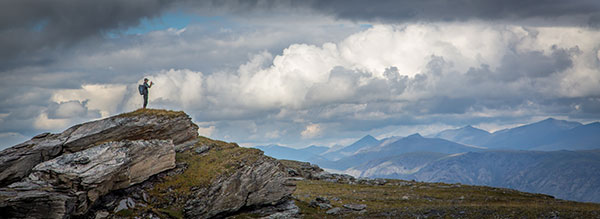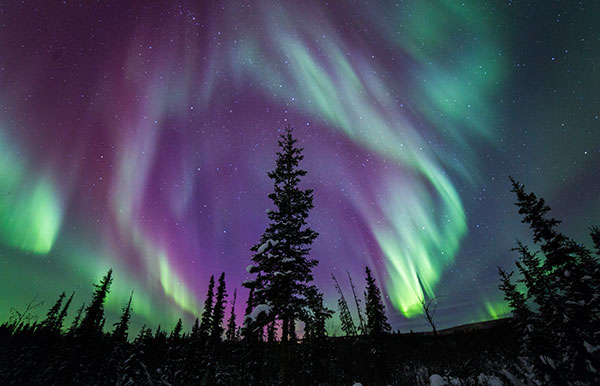Land Lines: How to Use Lines in Nature to Draw the Viewer Into Your Landscape Photos

From my perch on a rock outcrop above the Arctic River, I could make out every detail of the valley. The autumn tundra was a mosaic of red, orange, and yellow. The river flowed pale blue below the gray of storm clouds that were, in turn, lit with just a hint of sunset light.
I wasn’t sure how that last splash of color found its way through the lowering clouds and veils of rain, but it lit the valley in rose light. In the scene before me the high-contrast lines stood out: the blue river aside the red tundra, the crisscrossing ridges of the mountains, and the edges of swirling clouds.
This, like every scene, was a maze of interacting lines. My job was to take those confused lines and organize them into a single, successful image. To use those lines—some clear, some simply implied—I needed to reduce the chaos to an image pleasing to the eye. There above the river it was easy, as the light, the color, and the interaction of all those elements came together as though I’d planned it.
I composed, focused, and shot.
The Image Hook
We look at good images for an extended period of time; they catch and then hold our eyes. Why is this? Good photos have a compelling view-route through them. We wander from element to element following literal or implied lines as we go.
The length of time we can keep a viewer interested and entertained by the scene is a great indicator of the success of the image. If someone looks at a photo and says “pretty” and then immediately flips to the next page, we may have missed something. A big part of “Wow!” images is making sure that the viewer has something to linger over. That’s why lines are so important. They guide us, make us think about, and loiter over an image.
Not every scene comes together with such ease, so as landscape photographers we need to understand how the lines of an image work and how their placement will impact the final shot. Lines serve as the roadmap through an image and show the way for the viewer’s eyes to pass over the frame.
Often, those lines are literal—they follow elements in the image—but sometimes they are simply implied. Implied lines track depth, planes, or occur between two interacting elements. Literal lines are the most straightforward so I’ll start there.
Literal Lines
True, real, or literal lines are made up of features in the landscape: rivers, horizons, clouds, trees, buildings, etc. They can be straight or curved, remain entirely within the frame, or extend beyond the edges of the image. Even when composing a shot, real lines are clear to the eye and you need to pay attention to them.
When looking at photographs, our eyes naturally follow lines. From the main subject (the point of entry into an image), we track through the photograph. In landscape photos, literal lines are common, and we use those to guide us through the image.
Take, for example, the image of the river I described above. In this case, our eyes first fall on one of two likely places: the mountains in the background or the river. If your eyes first fall to the river, they will naturally be drawn to that other area of interest, the mountains, by following the curve of the river up the valley toward the rain-shadowed mountains. If the mountains first captured your eye, then you will naturally follow the flow of the river down to the lower right. In either case, the viewer’s vision has passed pleasingly throughout the entire photograph.
In a simpler example, I was photographing in early winter near my home in Fairbanks, Alaska. The winter sun never gets far above the horizon and even by mid-morning it was still low and gentle. I found myself in a forest of tall birch trees on a hillside where the sun tore through the vertical trunks in long beams. The lines of the tree trunks carried my eyes skyward, past the glowing sun, toward the pastel blue sky through the branches.

This was how I viewed the scene in life, and I knew it would translate well to an image. I raised my camera, composed in a way to lure the eye upward through the frame, and shot.
In this case, the pattern of lines is direct. It is a simple but effective motion through the image from the bottom center toward the top. There is enough interest that the viewer wants to linger on their journey through the photo, or even return to the start to make the trip again.
Repeating lines are very effective in image composition. The trees above are one example, but so is the image of the sunrise reflected in the water. This shot is almost an abstract, and the repeated, nearly identical, horizontal lines provide interest that gives the viewer the excuse to linger and look.

Literal lines don’t need to be complex, perhaps even shouldn’t be; they should be interesting, but not confusing. This is a difficult but important distinction.
Implied Lines
Implied lines don’t exist in a physical sense, but they are clear in an image nonetheless. Implied lines are elements that draw your eyes from one place on the frame to another. When humans or animals are included in an image, they almost always bring with them an implied line: the direction they are looking. In the image of a man atop a rock, you can see he is looking to the right.
That position makes the viewer curious about what he is seeing. The viewer then looks through the frame, passing over the valley and to the distant mountains. This is a clear and simple path through the image.
Depth is another type of implied line, one in which the eyes naturally slide from close to far. Humans view the world from close to far. We first want to know where we are stepping and then concern ourselves with our destination.
It’s no different with a good landscape image. Our eyes will naturally slide from the foreground to the background, then move back and forth between the two. While not all images need to show clear depth, it’s a useful and effective technique, assuming that other distracting or unnecessary elements aren’t included in the process.

Complementary elements also have implied lines between them. Similar shapes, colors, or textures can also connect. In the image of the aurora borealis and the spruce tree, I saw the form of the aurora and quickly adjusted my composition so that it appears to wrap around the tree. These echoing forms relate to one another and the viewer’s eyes will naturally flit back and forth between the two.

Another example is the image of the grizzly in the meadow with the dome of rock in the background. The bear in the lower right and the mountain in the upper left manage to echo one another, in general shape and color, forming an implied line between. These two images show how elements can be visually connected due to their similarity in form and color even if they are otherwise unrelated.


Conclusion
The presence, or purposeful absence, of connecting lines can make an image successful. Or, if they are misplaced, can cause a photo to fail. Whether real or implied, lines guide the viewer through the photo, but if there isn’t enough interest along the way, then you’ll lose them. The subject, colors, tones, drama, light, textures, and juxtapositions are what hold your viewer to an image and draw them into the scene. But the lines between those elements are what ties a successful image together. Consider them, use them, and, above all, don’t forget them.
David W. Shaw is a professional photographer, science and nature writer, and wilderness guide from Fairbanks, Alaska. Learn more about his work and how you can join him on a photography workshop at david-w-shaw.com.
- Log in or register to post comments













































